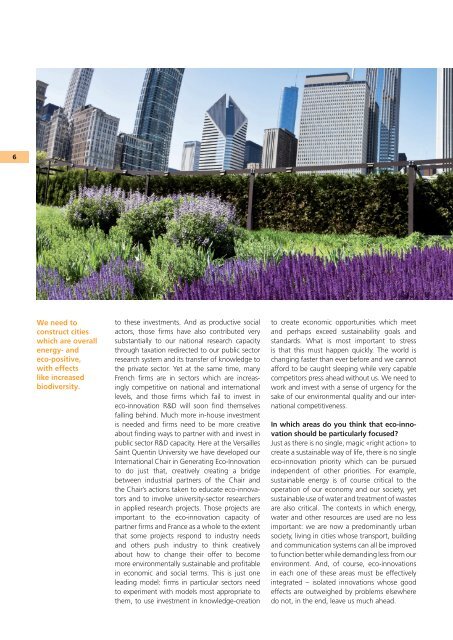SD Vision - Halyps Cement
SD Vision - Halyps Cement
SD Vision - Halyps Cement
You also want an ePaper? Increase the reach of your titles
YUMPU automatically turns print PDFs into web optimized ePapers that Google loves.
6<br />
We need to<br />
construct cities<br />
which are overall<br />
energy- and<br />
eco-positive,<br />
with effects<br />
like increased<br />
biodiversity.<br />
to these investments. And as productive social<br />
actors, those fi rms have also contributed very<br />
substantially to our national research capacity<br />
through taxation redirected to our public sector<br />
research system and its transfer of knowledge to<br />
the private sector. Yet at the same time, many<br />
French fi rms are in sectors which are increasingly<br />
competitive on national and international<br />
levels, and those fi rms which fail to invest in<br />
eco-innovation R&D will soon fi nd themselves<br />
falling behind. Much more in-house investment<br />
is needed and fi rms need to be more creative<br />
about fi nding ways to partner with and invest in<br />
public sector R&D capacity. Here at the Versailles<br />
Saint Quentin University we have developed our<br />
International Chair in Generating Eco-Innovation<br />
to do just that, creatively creating a bridge<br />
between industrial partners of the Chair and<br />
the Chair’s actions taken to educate eco-innovators<br />
and to involve university-sector researchers<br />
in applied research projects. Those projects are<br />
important to the eco-innovation capacity of<br />
partner fi rms and France as a whole to the extent<br />
that some projects respond to industry needs<br />
and others push industry to think creatively<br />
about how to change their offer to become<br />
more environmentally sustainable and profi table<br />
in economic and social terms. This is just one<br />
leading model: fi rms in particular sectors need<br />
to experiment with models most appropriate to<br />
them, to use investment in knowledge-creation<br />
to create economic opportunities which meet<br />
and perhaps exceed sustainability goals and<br />
standards. What is most important to stress<br />
is that this must happen quickly. The world is<br />
changing faster than ever before and we cannot<br />
afford to be caught sleeping while very capable<br />
competitors press ahead without us. We need to<br />
work and invest with a sense of urgency for the<br />
sake of our environmental quality and our international<br />
competitiveness.<br />
In which areas do you think that eco-innovation<br />
should be particularly focused?<br />
Just as there is no single, magic «right action» to<br />
create a sustainable way of life, there is no single<br />
eco-innovation priority which can be pursued<br />
independent of other priorities. For example,<br />
sustainable energy is of course critical to the<br />
operation of our economy and our society, yet<br />
sustainable use of water and treatment of wastes<br />
are also critical. The contexts in which energy,<br />
water and other resources are used are no less<br />
important: we are now a predominantly urban<br />
society, living in cities whose transport, building<br />
and communication systems can all be improved<br />
to function better while demanding less from our<br />
environment. And, of course, eco-innovations<br />
in each one of these areas must be effectively<br />
integrated – isolated innovations whose good<br />
effects are outweighed by problems elsewhere<br />
do not, in the end, leave us much ahead.


